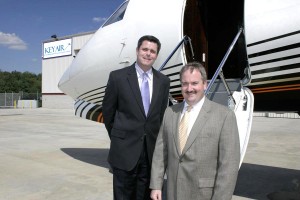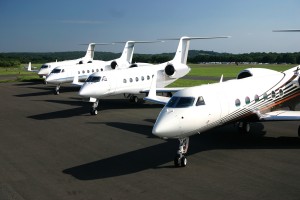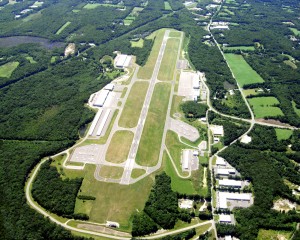
Brad Kost, CEO of Key Air and Keystone Aviation Services (left), and David Blackburn, president of Keystone Aviation Services, form a qualified management team.
By Clayton Moore
Serving the needs of corporate air travelers in the Northeast takes a special kind of organization. Fortunately, corporate travelers trying to circumnavigate the congested air space around New York City have an oasis nearby. Key Air, an aircraft management service based in Oxford, Conn., and its sister company, Keystone Aviation Services, a full-service fixed base operation, have the capabilities to satisfy nearly any aviation need.
Founded at Waterbury-Oxford Airport (OXC) in 1986 with a 12,000-square-foot hangar, the Key Air/Keystone companies recently celebrated their 20-year anniversary as well as the expansion of already substantial facilities. Keystone Aviation recently completed the largest freestanding corporate aviation hangar facility in the New York area. Hosting the Porsche Business Aircraft & Jet Preview on June 21 provided an opportunity to show off their facilities.
“We consider ours the most beautiful facilities in the Northeastern United States,” said Brad Kost, president and CEO of both companies.
Keystone Aviation is poised to deliver nearly 300,000 more square feet of combined hangar/office facilities in the near future. It’s an impressive track record and a tribute to an organization that is dedicated to customer service.
Two years ago, the shareholders that control both companies hired Kost, a native of Oxford with more than 15 years of corporate aviation experience, to serve as president and CEO. Kost believes it was an “ideal marriage.”
“This is homecoming for me,” Kost said. “My family is in Connecticut, and I’m a New Englander at heart. I’ve been following this company since I graduated from Embry-Riddle University in 1990. All that time, I kept looking at this airport and thinking what an incredible gem it is. The capabilities and strategic location all pointed towards what this airport might be able to accomplish. Developed and guided properly, this company is set to take off.”
Two companies, one goal
The two companies work hand in hand but have divergent functions and duties.

Key Air specializes in managing and chartering long-range, large cabin aircraft, including Gulfstreams, Hawkers and Challengers.
“We think about Keystone Aviation Services as the ‘stone,'” Kost explained. “It’s the brick and mortar that has always been here. Keystone basically controls the real estate, fuel and services side of things for the airport. On the other side is the Key Air facility, which manages long-range, large-cabin aircraft and directs the operations of several charter aircraft as well.”
While their roles might be distinct, the 115 employees spread across the two companies work closely together, and the two operations have a symbiotic relationship that brings them in close working proximity.
“We do have two different businesses with different operational models between them, but we’re all one company,” Kost said. “Each is supportive of the other, and they really couldn’t exist independently of each other. Key Air relies heavily on Keystone as a supplier of fuel and hangar services and real estate support. Meanwhile, Keystone relies heavily on Key Air in that the management company is the largest fuel customer of the FBO and provides a number of ancillary services, such as cleaning and catering.”
Keystone Aviation’s primary focus is fuel sales, an area where the company has experienced double-digit growth for the past five years. Keystone is an Avfuel distributor and the largest fuel station on the field. The FBO subcontracts its maintenance and repair operations for single-engine aircraft, piston twins and turboprops.
Back on the Key Air side of the field, the company has 18 aircraft under management and operates 15 aircraft for charter operations, specializing in late model, mid- and large-cabin aircraft, including Gulfstreams, Hawkers and Challengers. More than 80 employees ensure first rate customer service and operations. A specialized team of maintenance personnel employed by Key Air is dedicated only to its fleet.
“We’re really only taking care of our own aircraft—meaning that we specialize in our own planes,” Kost said. “It’s not like running a Part 145 repair station. We have 18 technicians just for our own aircraft. There’s a lot of grey hair in that department, but there are also a lot of young people that we’re bringing up through the ranks, because the technology has changed in a lot of these aircraft.”

Keystone Aviation Services manages more than 200,000 square feet of corporate hangar space at Waterbury-Oxford Airport in Connecticut.
Kost believes that dedicated approach to servicing their high-end clients is one of the major attractions for new customers.
“One of the things that separate our company from the competition is our dispatch reliability, from both the FBO and Key Air,” he said. “If we can’t get an aircraft up because of unforeseen circumstances, we have the depth in our fleet to replace it. We don’t have to wait for third-party maintenance to come in to work on our airplanes. Our technicians are usually here three hours before all flights, doing pre-flight checks right alongside our pilots. We try to fix any problems right then and there, to get aircraft flying.”
Now that the real estate and infrastructure at Keystone Aviation is much more developed, Waterford-Oxford Airport is poised to become one of the most essential aviation facilities in the Northeast. Kost credits the progress not only to his own companies but also to the airport’s management personnel and local FAA authorities.
“The airport has aggressively taken on the challenge of meeting the demand for aviation in this area,” Kost said. “The FAA and our local FISDO (Flight Inspection Safety District Office) has been amazing in helping us grow our business, giving us guidance and helping us work within new regulations facing the industry. We’ve extended the runway to 5,800 feet and built a control tower. We’re in the process of getting customs at the airport this year, which will present a real advantage. The airport dynamics and the infrastructure have changed dramatically over the past five years, preparing us to meet the needs of the caliber of people who are using this airport.”
The best kept secret in corporate aviation
The Keystone Aviation facilities, combined with the Key Air operations, represent a significant amount of real estate, even by the standards of the larger airports close to the New York City metropolitan area. A new 65,000-square-foot ClearSpan hangar was completed last year and includes an attached 40,000 square feet of office space, all currently occupied. Key Air currently controls more than 200,000 square feet of corporate hangar space and 100,000 square feet of office suites at the airport and plans to add more facilities in coming years.

Oxford-Waterbury Airport has recently constructed a control tower and extended its runway to 5,800 feet, to meet rising demand of corporate aviation traffic.
“We’re getting ready to start another construction project to expand our facilities further,” Kost said. “We’re building another 150,000 square feet of hangar space and another 140,000 square feet for high-end office space and a maintenance shop. We’re not afraid of construction, and we’re no stranger to it. Maybe we’re only really happy when we have some kind of construction project moving forward. It’s what we’ve been doing for 20 years as we built out this facility.”
The hard work represented by the two companies and their partners on the field represents just one part of a successful equation. Another is the Waterford-Oxford’s location, within striking distance of the highly prized aviation markets of New York, Teterboro and even Boston. Locals call the airport one of corporate aviation’s best kept secrets, but the area is gaining more attention because of the reputation of Key Air and Keystone Aviation.
“For 20 years, we’ve been developing this airport to meet the demand throughout the Northeast, specifically targeting the New York and Boston markets,” Kost said. “We’ve built a country club atmosphere here in western Connecticut that is strategically placed within a 15-minute flight from any New York airport and 30 minutes from Boston. We want to provide a home for aircraft and customers at the high end of the market, in terms of long-range aircraft, and provide the maintenance, support and management experience they need.”
That proximity to the New York market means more access and efficiency for customers using Key Air’s charter services.
“Say we’re picking up a client in New York, and Teterboro is experiencing long delays,” Kost used as an example. “We can move the pickup to LaGuardia, White Plains, here or any other airport that isn’t experiencing that delay. Over the last 24 to 36 months, we’ve also starting to see customers taking the extra half-hour to drive to this airport and depart directly from Waterford-Oxford. That’s because we show them service that is second to none. We’re able to give them that intimate, boutique style of service they’ve come to expect in all the other areas of their lives.”

This building is under construction but will soon be home to a high-end restaurant and catering facility.
Many budget-minded corporations are utilizing Waterford-Oxford because of Connecticut’s business-friendly disposition.
“The pricing and cost structure of real estate here allows us to be more competitive and provide a better value for flight departments with extensive operations,” Kost observed. “Overall, Key Air and Keystone provide value in a lot of different areas, including better maintenance, cheaper fuel and lower hangar rents than the metropolitan areas. Connecticut is a very pro-aviation state. There’s no sales tax on the sale of aircraft or the parts and services associated with aircraft management (for aircraft with a maximum takeoff weight of at least 6,000 pounds). That status has convinced some of New York’s major financial entities that are very savvy when it comes to costs to move their planes here.”
While Keystone Aviation provides the brick-and-mortar facilities for aircraft owners, the community of Oxford also draws many of its tenant owners as well as professional pilots. Corporate aviation remains the companies’ bread-and-butter—over 75 jets are housed at the airport—but there’s also a healthy general aviation community composed of local aircraft owners and corporate pilots.
“A lot of the management companies store their planes here,” Kost observed. “It makes sense, because a lot of the crewmembers live near here. This area provides a much higher quality of life than the metropolitan areas. Even though there are a lot of jets here, many of the pilots and crewmembers keep their own planes here. We’re even looking at another T-hangar development project for microjets and piston airplanes. We’re catering to all areas of the market. We build a good number of large facilities, but we build smaller facilities as well.”
The community’s attraction has led to a genuine feeling of camaraderie among the aviation professionals who call the airport home.
“This area of Connecticut is home to a lot of the corporate and commercial pilots flying out of the bigger airports,” Kost said. “Unfortunately, a lot of support staff for these types of airplanes can’t afford to have this quality of life in the major metro areas, but here, they’ve been able to find that balance. It’s very fraternal in nature. You can go out to any restaurant here, and you’ll run into a couple of people you know from our industry. That’s a nice thing.”

This new hangar at Keystone Aviation Services is home to a host of large-scale corporate jets and is the largest freestanding corporate aviation hangar in the New York metropolitan area.
In fact, Waterford-Oxford Airport will even have its own little clubhouse, of sorts, courtesy of Keystone Aviation. The company has formed a partnership to bring a sophisticated restaurant to the location. The new restaurant is scheduled to open in August.
“We’re building the restaurant to round out the community and extend the club-like atmosphere that we’ve been building,” Kost said. “A very high-end restaurant organization from New York will run it. This will be the organization’s first facility, and we’re hoping it’s the first of many. They will not only operate a high-caliber restaurant, but will also manage special events and provide catering for the aircraft that frequent this airport. It’s already started to support some of the flight departments here at the airport, and the product, packaging and presentation have been phenomenal.”
Looking to the future
Kost feels indebted to the shareholders and the aviation community that surrounds Key Air and Keystone Aviation Services, and he’s dedicated to ensuring the success of the companies. Prior to joining Key Air, he was president of Galaxy Aviation in West Palm Beach, Fla. He honed his management skills at reputable flight organizations like American Beechcraft and Signature Flight Support. But as a Connecticut native, his heart belongs to Waterford-Oxford Airport.
“The opportunity to provide value for the shareholders, for both companies, and for the airport community was too much to pass up,” he said. “This area is one of the most unique situations in corporate and general aviation that I’ve ever seen. It’s poised very well to meet the demands of the small aircraft market, including the very light jets that are coming in, but also to meet the demands of corporate aviation. We’re on the fringe of the metropolitan congestion in the New York area, but we have an ease of operation, a quality of life and a quality in operations that are going to allow this airport and our business to grow.”
Kost hopes to solidify relationships with current customers and to bring new clients into the family.
“The relationships we’ve developed over the years are very important to us,” he said. “The most important aspect of our marketing is by word of mouth from customers. We’re going to do everything we can to take care of them while we move forward. At the same time, we also want to open corporate aviation to people who may not have been exposed to it before. If they have pleasurable experiences, we can build upon them for the future.”
First on the drawing board is the imminent expansion of the Keystone Aviation and Key Air facilities. But the forward-looking organization is also keeping its eyes on other areas.
“As we go forward, we’re going to continue to do everything we can to provide value and strategically grow this business in other areas throughout the country,” Kost said. “It makes sense for us to duplicate the facilities and management expertise that we have here. We may eventually do some international expansion as well. We’re actively looking into other areas, and I think some big announcements will be forthcoming in the not-too-distant future.”
For more information about Key Air, visit www.keyair.com. To learn about Keystone Aviation Services, visit [http://www.keystoneav.com].











